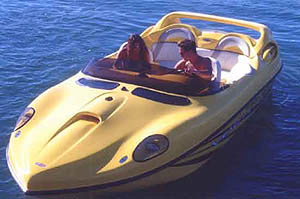Laser Vortex
Peter Bentley tests the latest from Performance Sailcraft
Is it a bird "is it a plane". No, it's the Laser Vortex. Neither catamaran nor monohull. Equally at home as a performance racer or a holiday resort fun-boat, Laser's latest offering simply defies description in any normal category. That's not to say the Vortex is hard to define — fast, simple, fun are the three adjectives that most easily come to mind though virtually any selection of words in a similar vein would suffice. The Vortex is quite simply something different.
We had been hoping to pick a gentle spring day to put the Vortex through her paces but as anyone who has tried to sail this spring will know, the weather has not always been cooperative. In the end we managed to go afloat when it was not actually raining ... but is was blowing the top side of twenty knots. Add in the usual wind-against-tide chop in the Solent and things were really starting to get challenging.
Designed by dinghy and multihull guru Jo Richards, the Vortex is intended as a fun boat providing high-performance sailing without the acrobatic skills and athleticism required for some of the more advanced designs. The Vortex will be equally at home as a beach-resort boat, high speed blasting around the bay and lately, as a circuit starts to develop, serious racing. As always, Jo has stepped outside the mainstream design envelope to produce a boat that looks and sails like no other.
Jo would be the first to admit that there is nothing really new in sailing and claims to have drawn on experiments in the International Moth fleet in the 1970s for part of his inspiration. As with any design, compromises have had to be made. No doubt there will be those who criticise the boat for it's lack — by multihull standards — of ultra-high performance. Others will questions her looks, which are quite stunning if a little unusual. In the final analysis anyone who stands back and takes a balanced view will quickly realize that the Vortex is a boat that redefines the design limits, bringing genuine high performance singlehanded trapeze sailing within reach of the vast majority of dinghy sailors.
Set against the undoubted success of the concept, there are a few teething problems. Hoisting the mainsail on our test boat proved to be a two-man job and a difficult one at that. A mismatch between the luff groove in the mast and the bolt-rope had the sail alternately trying to jump the track and jam in the groove. Eventually we did get it all the way up, whereupon it cleats simply at the base of the mast. A very big pull was required to lock the sail at the top of the mast and it continued to descend slowly throughout the test. The halyard tail tucks neatly away in a pocket on the foot of the mainsail and the split lower section simply zips around the mast. The cunningham hooks into two webbing loops at the bottom of the mainsail. Annoyingly, the rope was too long and even though we tied it off short, the end-limited travel in the adjustment system made it difficult to get enough tension on the luff.
Launching proves simple with the custom built trolley making light work of handling the boat ashore. Once in the water, the Vortex is a stable as the proverbial Battle Ship. Getting off the beach can prove tricky for the uninitiated; if you start in the head to wind position the Vortex has a strong tendency just to go backwards. The trick is to start with the bow pointed off a little and then sheet in.
The Vortex's sailing performance upwind and down is quite remarkable and all the more so considering he rather modest size. On any point of sail , there is enough righting moment to sail away cleanly with the helmsman just sitting on the side. Push out onto the wire and the fun really begins. Upwind she performs best catamaran style with the windward hull just kissing the wave tops. The steering is precise and well balanced, with the single rudder offering plenty of bite right up to quite extreme angles of heel. For the size and speed of boat, the dagger boards are quite large (something to do with making them the same size as the rudder one suspects) and once the breeze builds much in to double figures, it seems to be best to raise them a little even upwind. This can be a problem as there does not seem to be much to stop the boards falling back down again under the force of gravity.
The main sheet load is perhaps higher than one might expect, though far from unmanageable. In many respects the cunningham proves to be the main power control with the upside-down vang working well to control twist. Both are easily worked from on the wire and in the boat.
Best speed in a breeze is obtained, as with most una-rigged boats, with the main sheeted well outboard and the boat powered up and moving fast. The motion is quick, though not so sharp as to provide difficulties in hanging on. There is little or no tendency to nose dive going upwind, always provided the crew weight is well back. Beware though if you do put the bow into a big wave as there is only one foot loop and it is too far back for upwind work.
Tacking holds no fears but does need to be undertaken in a confident manner if a spell of backwards motion is not to impede progress. Provided the tack is entered with speed, the bow spins through the wind with ease. Go in too slowly and the Vortex does tend to hang in irons. Even then all is not lost and a quick reversal of the helm soon sees the bow paying way on to the new tack.
Getting in and out on the wire can be somewhat challenging to start with. In difference to the back of the crew's legs when the boat is sailed in two-up mode, there are no push-of bars to help you get out on the wire. Similarly, the non-slip on the topsides does not extend quite far enough up to provide a firm grip when moving in or out.
Downwind the fun really begins. Powered up reaching, the Vortex simply flies. As when going upwind, you need to get the weight well back but control is never an issue. As with upwind sailing, best speed is obtained with the weather hull just flying. It certainly is possible to put the bow down the mine, but provided you rapidly release some sheet the most likely outcome will be for the bow to pop out. Beware though as the resultant deceleration is enough to sweep the helmsman forward at quite a rapid rate — towards the slightly intimidating narrow trailing edges of the now raise dagger boards.
With enormous reserves of both static and dynamic stability the Vortex is actually quite a hard boat to capsize. At rest, a seriously heavy helmsman can stand on one side with no loss of stability. Even badly mishandled at speed the Vortex will get her self out of trouble on most occasions. Beware if you do capsize though. By her very nature, most tip-ups occur at speed and there is always a risk of injury when you go flying through the air. More significantly, the sealed mast ensures the Vortex does not invert easily, presenting a significant area of hull to the wind once she is on her side. In any amount of breeze downwind drift is faster than all by the strongest swimmers will be able to manage.
Righting is no harder than for any traditional dinghy, with the centerboards sufficiently close to the water the make climbing up easy. Handles on the underside of the hull provide something to hang onto. Even from inverted there are no dramas with plenty of weight aft soon inducing the boat to pop up onto her side.
The rig is simple if somewhat unusual with three spreaders (the forward one goes to the split-forestay) used to control bend. Jo's reasoning for using this set up was simple. "If the International Moths with no rules have all gravitated to it with 20 years of development it must be about right." Mast rake is adjusted via shroud plates Bend in the Proctor mast is certainly well controlled
Not many boats have three foils and fewer still can claim to have three identical ones. The rudder and centreboards on the Vortex are all made from a simple one-piece aluminium extrusion with plastic end caps. A short rope handle at the top completes the job. Laser have made the decision to leave the extrusions hollow which does allow some water in. The alternative, to foam fill the blades, was rejected on the grounds that foam always soaks up water and the weight would increase gradually with time. After sailing the water can be drained out by simply turning the blades upside down. Empty, there is sufficient buoyancy to provide flotation and the rate of leakage is sufficiently low that they would remain afloat for some time if inadvertently dropped in the water.
Unusually, the Vortex is not produced in Laser's own factory in Banbury but at Rob White's premises in Brightlingsea. Construction appears to be of high quality and utilises glass, foam and vinyl ester resins. What few fittings there are all appear to be man enough for the job and everything functions effectively.
There can be no doubt that the Vortex redefines the concept of simple high performance sailing. Sure, there are boats that go faster and boats that are simpler to sail but non that even comes close to combining the two with such ease. Even with no previous trapezing experience almost anyone who can sail a Laser ought to be able to get to grips with the Vortex in an afternoon. Perhaps unsurprisingly, Laser is slightly baffled by the instant success of a boat that does not fit easily into the established pattern of small boat sailing. Production has been doubled and then doubled again since the Vortex was launched at the London Boat Show and still Laser can not keep up with demand. Only rarely does something genuinely new come along in sailing and it seems the buying public have not been slow to realize it.












